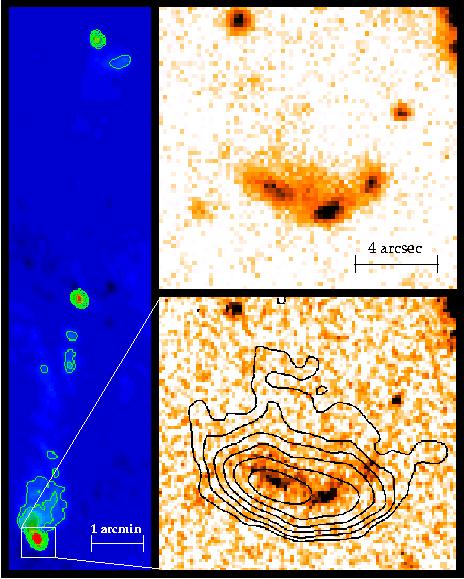Researchers of the Institute of Radioastronomy are working in collaboration with collegues at the European Southern Observatory and at MPIA-Heidelberg to observe and interpret optical emission from hot spots in radio galaxies. Part of this work has recently published in Science (Prieto, Brunetti, Mack, 2002, 298, p. 193) and received attention in several magazines and newspapers.
Hot spots (HSs) are regions of enhanced radio emission located at the end of the radio lobes of powerful extragalactic radio sources (FR II). These bright regions mark the interaction between the supersonic jets launched by the active nucleus with the surrounding intergalactic medium. It is believed that a substantial fraction of the kinetic energy of the jet is converted into particle acceleration in these regions. The radio spectra of the HSs are interpreted in terms of synchrotron radiation from the accelerated relativistic electrons.
Although radio HSs are very common, the detection of their optical synchrotron radiation is difficult due to the natural decay of the synchrotron spectrum toward higher frequencies and only few optical HSs have been discovered in more than 20 years of observations. Yet, the optical detection of HSs has a number of fundamental implications in our understanding of the physics of particle acceleration in these regions since optically emitting electrons (with Lorentz factor about 10**5 to 10**6) have a radiative cooling-time about 300 times shorter than that of the radio-emitting electrons. Indeed, the short cooling-time of optical electrons as well as their diffusion length scale of much less than 1 kpc make high-resolution optical imaging an unequaled tool to pick up those regions where high energy electrons are accelerated.
We used ESO's Very Large Telescope (VLT) to search for optical counterparts of a sample of HSs. For the first time, the HS targets were selected on the basis of theoretical predictions. In particular, we selected low synchrotron brightness HSs which would have relatively low magnetic field strengths and thus a relatively long cooling time of the optically emitting electrons (proportional to B**(-3/2) ). As a matter of fact, we obtained an unprecedented about 70 % detection rate and in only one VLT run we doubled the number of known optical HSs. Of particular relevance resulted the case of the southern HS of radio galaxy 3C 445. The emission from this HS is resolved in compact regions (Fig. 1) where most of the kinetic power of the jet is dissipated into very efficient particle acceleration. In particular, the central, brightest, knot is most likely the region of the impact of the jet with the intergalactic medium in which a strong shock is formed and accelerates relativistic electrons via Fermi-I mechanisms.
In addition, the optically emitting electrons are distributed on a 3 to 5 kpc scale suggesting that particle acceleration does not happen only within the shock formed at the head of the jet, but in a much more extended region. This discovery has partially changed our view of particle acceleration in radio galaxies as it directly proves that additional acceleration mechanisms (most likely Fermi-II) powered by the dissipation of the kinetic power of the jet in the cocoon, may contribute to electron re-acceleration.
Immagini:

